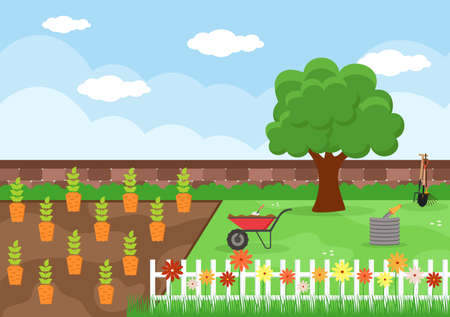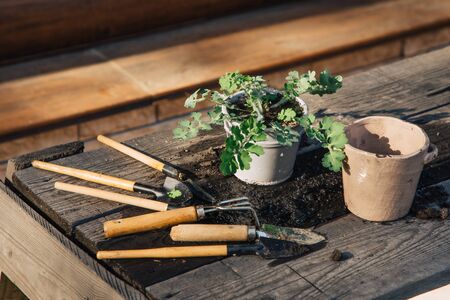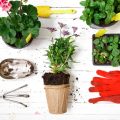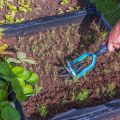Essential Hand Tools for Everyday Gardening
If youre just starting your gardening journey, investing in a few basic hand tools can go a long way. These tools are affordable, easy to use, and perfect for handling everyday gardening tasks like digging, planting, weeding, and pruning. Heres a look at the must-have hand tools every beginner gardener should have in their toolkit.
Trowel
A garden trowel is one of the most essential tools for any home gardener. Its perfect for digging small holes, transplanting seedlings, and scooping soil or compost. Look for one with a comfortable grip and a sturdy stainless steel blade to ensure durability without breaking the bank.
Pruners
Also known as hand pruners or secateurs, these are used for trimming small branches, deadheading flowers, and cutting back perennials. Bypass pruners are ideal for clean cuts on live plants, while anvil pruners work well on dry or dead stems. A good pair of pruners can last years with proper care.
Hand Rake
This small rake is great for clearing leaves, loosening soil, and tidying up garden beds. Its compact size makes it easy to maneuver in tight spaces like flower beds or raised planters. Choose one with strong metal tines and an ergonomic handle for comfort during extended use.
Quick Comparison of Must-Have Hand Tools
| Tool | Main Use | Estimated Cost (USD) |
|---|---|---|
| Trowel | Digging & Transplanting | $5 – $15 |
| Pruners | Cutting & Trimming Plants | $10 – $25 |
| Hand Rake | Loosening Soil & Leaf Cleanup | $7 – $20 |
Pro Tip:
You don’t need to buy everything at once. Start with the basics like a trowel and pruners, then add more tools as your gardening skills grow. Many local garden centers also offer budget-friendly tool sets designed specifically for beginners.
2. Budget-Friendly Tools for Soil Preparation
Before you can grow healthy plants, you need healthy soil. Luckily, getting your garden beds ready doesn’t have to cost a fortune. There are several affordable tools that can help beginners prepare and maintain their garden soil without breaking the bank. Here are some essential low-cost options to consider:
Garden Forks
A garden fork is perfect for loosening compacted soil, turning compost, and breaking up clumps. It helps improve drainage and aeration, which are key to strong plant roots. Look for forks with sturdy steel tines and a comfortable grip—you can often find durable ones at local hardware stores or online for under $25.
Hoes
Hoes are great for weeding and shaping soil. A basic draw hoe or stirrup hoe helps remove weeds efficiently while also loosening the top layer of soil. They’re especially useful in vegetable gardens and flower beds. You can find budget-friendly hoes starting around $10–$15.
Hand Cultivators
These small, claw-like tools are ideal for working in tight spaces or raised beds. Hand cultivators help mix soil amendments like compost and fertilizer into the topsoil. Theyre lightweight, easy to use, and usually cost less than $10—perfect for new gardeners who want to keep things simple.
Quick Comparison of Soil Prep Tools
| Tool | Main Use | Typical Price Range | Best For |
|---|---|---|---|
| Garden Fork | Loosening and turning soil | $20–$30 | Larger garden beds, composting |
| Hoe | Weeding and shaping soil | $10–$20 | Vegetable gardens, weed control |
| Hand Cultivator | Mixing soil in small areas | $5–$10 | Pots, containers, raised beds |
With just these three tools, beginner gardeners can cover all the basics of soil preparation without spending too much money. They’re simple to use, widely available, and make a big difference in how well your garden grows.

3. Watering Tools That Won’t Break the Bank
Keeping your garden properly watered doesnt have to cost a fortune. Whether youre caring for a few potted plants or a small backyard veggie patch, there are budget-friendly watering tools that get the job done without draining your wallet. Here are some practical and affordable options to help you keep your plants happy and hydrated.
Essential Budget-Friendly Watering Tools
| Tool | Description | Best For | Average Price Range |
|---|---|---|---|
| Watering Can | A classic choice, perfect for precise watering of potted plants and flower beds. | Indoor plants, small gardens, seedlings | $5 – $15 |
| Garden Hose with Nozzle | A versatile tool that allows adjustable water flow for different garden needs. | Larger garden beds, lawns, container gardens | $10 – $25 |
| Soaker Hose | Delivers slow, steady moisture directly to the soil—great for conserving water. | Vegetable gardens, flower borders, raised beds | $15 – $30 |
Tips for Choosing the Right Watering Tool
- Start small: If youre new to gardening, a simple watering can may be all you need.
- Consider your garden size: A hose with a nozzle is better suited for medium to large spaces.
- Save water: Soaker hoses are great for reducing waste and keeping roots consistently moist.
- Look for sales: Big box stores and local garden centers often have seasonal discounts on basic tools.
Quick Tip:
If youre using tap water, let it sit out in the watering can overnight before using it on delicate plants. This helps chlorine evaporate and keeps your plants healthier.
Pro Tip:
Add a shut-off valve to your hose to control water flow right at your fingertips—it’s an inexpensive upgrade that saves both time and water!
4. Protective Gear for Safe Gardening
Staying safe and comfortable while gardening is just as important as having the right tools. For beginners, investing in a few basic pieces of protective gear can make gardening more enjoyable and help prevent injuries. The good news? You don’t have to spend a lot to get started. Here are three affordable essentials that every beginner gardener should consider:
🧤 Gardening Gloves
A sturdy pair of gardening gloves protects your hands from thorns, splinters, and dirt. Choose gloves made from breathable materials with reinforced palms for better grip and durability. Look for water-resistant options if you plan to work with wet soil or plants.
Recommended Features:
- Snug fit for better control
- Machine washable
- Padded palms for extra comfort
You can easily find quality gloves under $10 at most home improvement stores or online retailers.
🦵 Knee Pads
Kneeling in the garden for extended periods can be tough on your knees. A pair of foam or gel-filled knee pads offers cushioned support and helps prevent joint pain. Theyre especially useful when planting or weeding close to the ground.
Recommended Features:
- Adjustable straps for a secure fit
- Water-resistant exterior
- Lightweight design
Most beginner-friendly knee pads are available for around $10–$15.
👕 Lightweight Aprons
A gardening apron keeps your clothes clean and provides handy storage for small tools, seed packets, or your phone. Look for aprons made from lightweight canvas or cotton blends that are comfortable to wear during long sessions in the yard.
Recommended Features:
- Multiple pockets for convenience
- Adjustable neck and waist straps
- Easy to wash and dry
You can pick up a functional gardening apron for less than $20.
Quick Comparison Table
| Item | Main Benefit | Estimated Cost |
|---|---|---|
| Gardening Gloves | Hand protection & improved grip | $5–$10 |
| Knee Pads | Knee comfort & injury prevention | $10–$15 |
| Lightweight Apron | Clean clothes & tool storage | $15–$20 |
With these affordable pieces of protective gear, beginner gardeners can stay safe, comfortable, and ready to enjoy every moment spent outdoors.
5. Storage and Maintenance Tips for Longevity
Keeping your gardening tools in good shape doesnt have to be complicated or expensive. With a little care and smart storage, even budget-friendly tools can last for years. Here are some simple tips and ideas that are perfect for beginners working with limited space and budget.
Smart Storage Ideas for Small Spaces
If you’re short on space, storing your tools efficiently is key. Here are a few creative storage solutions:
| Storage Idea | Description |
|---|---|
| Wall-mounted Pegboard | Install a pegboard in your garage or shed to hang hand tools like trowels, pruners, and gloves. Keeps items visible and easy to reach. |
| Bucket Tool Organizer | Use a five-gallon bucket with a tool organizer insert to carry and store your essentials. It’s portable and great for small gardens or balconies. |
| Hanging Shoe Organizer | Hang an old canvas shoe organizer on the back of a door or wall to store small tools, seed packets, and twine. |
| Repurposed Wooden Pallet | Lean a wooden pallet against a wall and use the slats to hold rakes, shovels, and hoes upright. |
Easy Maintenance Practices
A little regular maintenance goes a long way in keeping your tools working well. Here are some beginner-friendly practices:
1. Clean After Each Use
Dirt and moisture can cause rust and wear. Rinse off soil from tools after each use and dry them thoroughly before storing.
2. Oil Metal Parts
Apply a light coat of vegetable oil or motor oil to metal blades and surfaces to prevent rusting. This is especially helpful for pruners, shears, and trowels.
3. Sharpen Blades Regularly
A sharp blade makes gardening easier and safer. Use a sharpening stone or file to keep edges clean—especially on pruners and hoes.
4. Tighten Loose Screws
Check handles and moving parts regularly. Tighten any loose screws or bolts to keep tools safe and functional.
5. Store in Dry Areas
Avoid leaving tools outside where they can get wet or sun-damaged. Keep them in a covered area like a shed, garage, or even under a bench with storage space.
Why It Matters
Taking care of your gardening tools helps you save money in the long run by avoiding replacements. Plus, well-maintained tools work better, making your gardening experience more enjoyable—even as a beginner!


